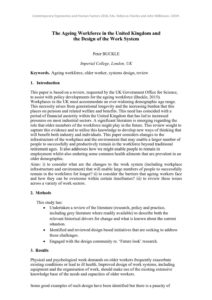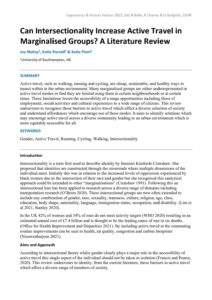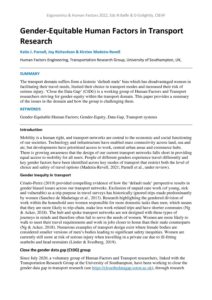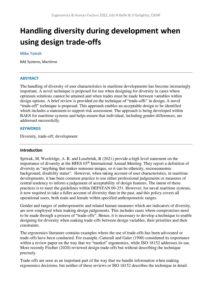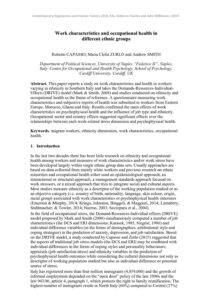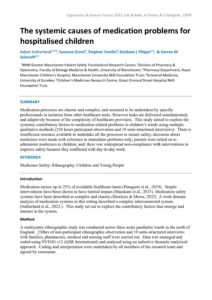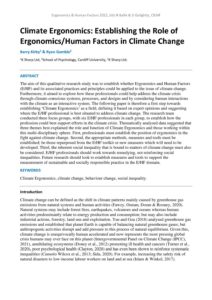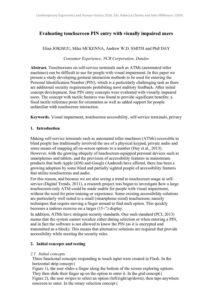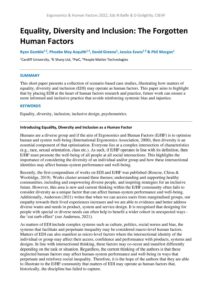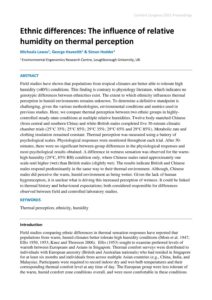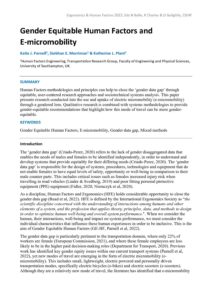Equality, diversity & inclusion (EDI)
The Ageing Workforce in the United Kingdom and the Design of the Work System
| Document | Author Peter BUCKLE |
| Abstract |
Can Intersectionality Increase Active Travel in Marginalised Groups? A Literature Review
| Document | Author Joy McKay, Katie Parnell & Katie Plant |
| Abstract Active travel, such as walking, running and cycling, are cheap, sustainable, and healthy ways to transit within in the urban environment. Many marginalised groups are either underrepresented in active travel modes or find they are limited using them in certain neighbourhoods or at certain times. These limitations lessen the accessibility of a range opportunities including those of employment, social activities and cultural experiences to a wide range of citizens. This review endeavours to recognise those barriers to active travel which affect a diverse selection of society and understand affordances which encourage use of these modes. It aims to identify solutions which may encourage active travel across a diverse community leading to an urban environment which is more equitably accessible for all. |
Gender-Equitable Human Factors in Transport Research
| Document | Author Katie J. Parnell, Joy Richardson & Kirsten Madeira-Revell |
| Abstract The transport domain suffers from a historic ‘default male’ bias which has disadvantaged women in facilitating their travel needs, limited their choice in transport modes and increased their risk of serious injury. ‘Close the Data Gap’ (CtDG) is a working group of Human Factors and Transport researchers striving for gender-equity within the transport domain. This paper provides a summary of the issues in the domain and how the group is challenging them. |
Handling diversity during development when using design trade-offs
| Document | Author Mike Tainsh |
| Abstract The handling of diversity of user characteristics in maritime developments has become increasingly important. A novel technique is proposed for use when designing for diversity in cases where optimum solutions cannot be attained and when trades must be made between variables within design options. A brief review is provided on the technique of “trade-offs” in design. A novel “trade-off” technique is proposed. This approach enables an acceptable design to be identified which includes a statement to support risk assessment. The approach is being developed within BAES for maritime systems and helps ensure that individual, including gender differences, are addressed successfully. |
Work characteristics and occupational health in different ethnic groups
| Document | Author Roberto CAPASSO, Maria Clelia ZURLO and Andrew SMITH |
| Abstract This paper reports a study on work characteristics and health in workers varying in ethnicity in Southern Italy and takes the Demands-Resources-Individual-Effects (DRIVE) model (Mark & Smith, 2008) and studies conducted on ethnicity and occupational health as the frame of reference. A questionnaire measuring work characteristics and subjective reports of health was submitted to workers from Eastern Europe, Morocco, Ghana and Italy. Results confirmed the main effects of work characteristics on psychophysical health and the influence of job type and ethnicity. Occupational sector and country effects suggested significant effects over the relationships between each work-related stress dimension and psychophysical health. |
The systemic causes of medication problems for hospitalised children
| Document | Author Adam Sutherland, Suzanne Grant, Stephen Tomlin, Denham L Phipps, & Darren M Ashcroft |
| Abstract Medication processes are chaotic and complex, and assumed to be undertaken by specific professionals in isolation from other healthcare tasks. However tasks are delivered simultaneously and adaptively because of the complexity of healthcare provision. This study aimed to explore the systemic contributory factors to medication related problems in children’s wards using multiple qualitative methods (230 hours participant observation and 19 semi-structured interviews). There is insufficient resource available to undertake all the processes to ensure safety; decisions about medicines were made with reference to immediate problems only; parents were relied on to administer medicines to children, and; there was widespread non-compliance with interventions to improve safety because they conflicted with day-to-day work. |
Climate Ergonomics: Establishing the Role of Ergonomics/Human Factors in Climate Change
| Document | Author Barry Kirby & Ryan Gamble |
| Abstract The aim of this qualitative research study was to establish whether Ergonomics and Human Factors (E/HF) and its associated practices and principles could be applied to the issue of climate change. Furthermore, it aimed to explore how these professionals could help address the climate crisis through climate-conscious systems, processes, and designs and by considering human interactions with the climate as an interactive system. The following paper is therefore a first step towards establishing ‘Climate Ergonomics’ as a field, defining it based on expert opinions and suggesting where the E/HF professional is best situated to address climate change. The research team conducted three focus groups, with six E/HF professionals in each group, to establish how the profession could best support efforts in the climate crisis. Thematically analysed data suggested that three themes best explained the role and function of Climate Ergonomics and those working within this multi-disciplinary sphere. First, professionals must establish the position of ergonomics in the fight against climate change. Second, the appropriate methods, measures and tools must be established; be those repurposed from the E/HF toolkit or new measures which will need to be developed. Third, the inherent social inequality that is bound to matters of climate change must also be considered. E/HF professionals should work towards remedying, not reinforcing social inequalities. Future research should look to establish measures and tools to support the measurement of sustainable and socially responsible practice in the E/HF domain. |
Evaluating touchscreen PIN entry with visually impaired users
| Document | Author Elina JOKISUU, Mike MCKENNA, Andrew W.D. SMITH and Phil DAY |
| Abstract Touchscreens on self-service terminals such as ATMs (automated teller machines) can be difficult to use for people with visual impairment. In this paper we present a study developing gestural interaction methods to be used for entering the Personal Identification Number (PIN), which is a particularly challenging task as there are additional security requirements prohibiting most auditory feedback. After initial concept development, four PIN entry concepts were evaluated with visually impaired users. The concept with tactile features was found to provide significant benefits: a fixed tactile reference point for orientation as well as added support for people unfamiliar with touchscreen interaction. |
Equality, Diversity and Inclusion: The Forgotten Human Factors
| Document | Author Ryan Gamble, Phoebe May Asquith1, David Greeno, Jessica Evans & Phil Morgan |
| Abstract This short paper presents a collection of scenario-based case studies, illustrating how matters of equality, diversity and inclusion (EDI) may operate as human factors. This paper aims to highlight that by placing EDI at the heart of human factors research and practice, future work can ensure a more informed and inclusive practice that avoids reinforcing systemic bias and injustice. |
Ethnic differences: The influence of relative humidity on thermal perception
| Document | Author Micheala Lawes, George Havenith & Simon Hodder |
| Abstract A protocol was developed to test theoretical assumptions associated with the interrelationship between thermal sensation, thermal discomfort, and physical contact temperatures in humans. To achieve this, perceptual responses (thermal sensation and thermal discomfort) to the application of seventeen absolute physical temperatures, ranging from cold to hot (18 - 42°C) were examined. In addition, the present study tested the confidence of participants in their thermal sensation ratings also, across a wide spectrum of thermal stimuli. Seventeen Western European university students volunteered and consented to participate in the study. The location of the application of the probe was marked on their skin, ensuring consistent application across temperatures, and all participants were blinded to the environment conditions, as well as the temperature of thermal probe controller unit, to avoid expectation bias. Physical temperatures were applied with a conductive thermal probe (Physitemp Instruments Inc., USA) consisting of a 25 cm2 metal surface, applied with a pressure of 4 kPa, in a mixed counterbalanced order. The probe was applied to the skin for 10 seconds for all applications, at the end of which participants rated their local thermal sensation, the confidence of thermal sensation, and local thermal discomfort. A recovery time between thermal probe applications of at least 20 seconds was used. Local skin temperature has been reported to have returned to its baseline value using a single spot infrared thermometer (FLUKE 566, Fluke Corporation, USA) prior to each subsequent thermal probe application. |
Gender Equitable Human Factors and E-micromobility
| Document | Author Katie J. Parnell, Siobhan E. Merriman & Katherine L. Plant |
| Abstract Human Factors methodologies and principles can help to close the ‘gender data gap’ through equitable, user-centered research approaches and sociotechnical systems analysis. This paper presents research conducted into the use and uptake of electric micromobility (e-micromobility) through a gendered lens. Qualitative research is combined with systems methodologies to provide gender-equitable recommendations that highlight how this mode of travel can be more gender-equitable. |

